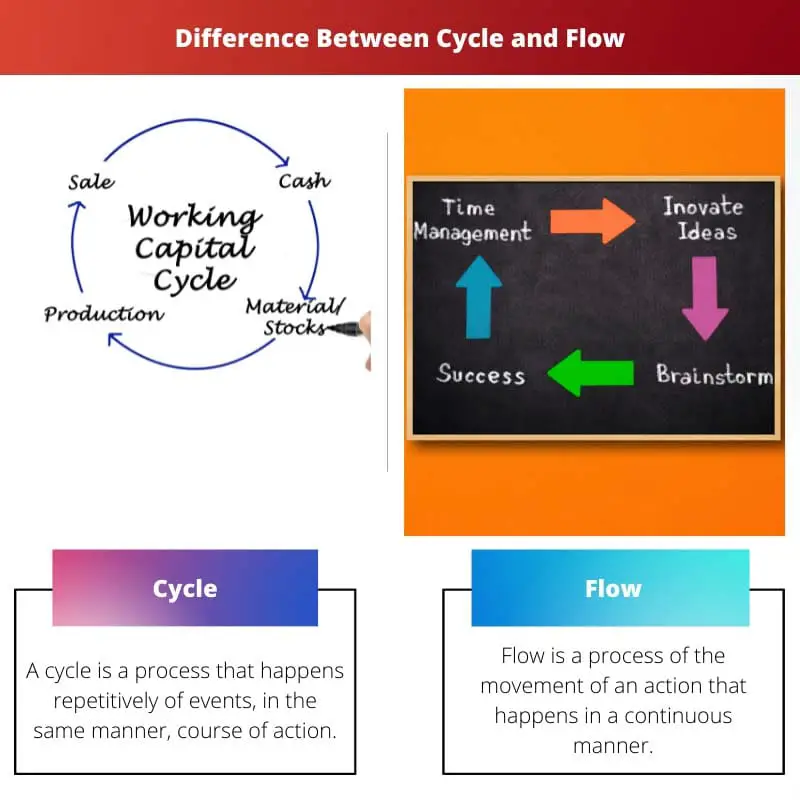Cycle and flow are two different terms that are used to indicate the process or movement of a course of action. Whereby, a
Cycle is a cyclic process that repeats an action in the same manner; Flow is a process of an action that runs in a continuous manner.
Key Takeaways
- A cycle is a series of events or processes that recur in a specific order, while flow refers to the continuous movement of a substance or elements within a system.
- Cycles occur in various natural and artificial systems, such as the water or business cycle, while the flow is observed in processes like blood or electricity.
- Cycles involve a return to a starting point, whereas flow does not necessarily imply a return to an origin.
Cycle vs Flow
A cycle is a series of events or processes that repeat themselves in a specific order and refers to the input, process, output, and feedback loop. A flow is the movement of something in a specific direction and refers to the inputs and outputs between different stages of a process.

In science and economics subjects, a cycle is defined as something that repeats its sequence of events after every period of time.
Mostly, the cycle concept is prevalent in science subjects, such as the water cycle, biogeochemical cycle, the rock cycle, and so on. For instance, the water cycle depicts the continuous movement of water from the earth to the atmosphere.
On the other hand, Flow is used to define the fluid motion that moves smoothly, steadily and continuously till it reaches its destination, unless and until no obstruction is induced to the movement.
Moreover, it is a physics and engineering study relating to the fluid’s motion subjected to different unbalanced forces.
Comparison Table
| Parameters of Comparison | Cycle | Flow |
|---|---|---|
| Meaning | A cycle is a process that happens repetitively of events, in the same manner, course of action. | Flow is a process of the movement of an action that happens in a continuous manner. |
| Etymology | The cycle was invented by Greeks as ‘Kyklos’ in the late 14th century. | Originated from the old English in the 15th century as Flown. |
| Types | There are numerous types of cycles such as the water cycle, nitrogen-sulfur cycle, etc. | Flow has various types as traffic flow, water flow, flow chart, turbulent flow, and so on. |
| Purpose | A cycle is mainly referred to in astronomy, economics, mathematics, electronics, and physics | Flow is used to observe the liquid or fluid form. |
| Direction | The cycle goes round like a circle, repeating its course of action. | Flow is a continuous movement in one direction. |
What is Cycle?
The concept of a cycle is used in astronomical science and economics to describe something that repeats its sequence of events in the same order and at the same intervals over any time.
The concept of a cycle is observed in various subjects, such as the water cycle, the menstrual cycle, the biogeochemical cycle, the life cycle, and so on. The word cycle has been in use since the fourteenth century.
It was initially derived from the Latin word ‘Cyclus’ and then from the Greek word ‘kyklos’; citing the circular body, basically a wheel. However, it is also referred to as a circular or spiral arrangement and commonly a vehicle named a bicycle.
As a result, the word cycle was predominantly used to define a movement or process that repeats its own sequence of events from time to time.
The water cycle is an example of how water continuously flows from the earth to the atmosphere. Furthermore, the most common example of a cycle is the seasons of a year, where summer is followed by fall, spring, and winter.
Subsequently, this pattern of seasons continues every year. While in astronomical physics, the rotation of the earth around the sun is interpreted as a cycle; since it repeats its movement over a period of time.

What is Flow?
Meanwhile, the word Flow defines fluid motion, an inexorable flow that continues smoothly, continuously, and without interruption until it reaches its destination.
Moreover, fluid dynamics is a study in physics and engineering about the motion or flow of fluids under the influence of unbalanced forces.
It is used in context to define the smoothness of the liquid or fluid inside a container or stream that continues to move along.
One fine example is the movement of a stream or the movement of a certain type of liquid or fluid from one container to another.
The word Flow has been in use since the fifteenth century. Originally, it was from the Old English word Flowan, meaning rinse, wash.
It was then descended from the Proto-Indo-European word pleu; eventually tending to the meaning of the word flow.
According to fluid dynamics(study of the flow of liquids or gases), turbidity, viscosity, density, and compressibility are flow’s four most important characteristics.
Besides, the fluid’s nature, the fluid, the speed of the fluid, and the shape of the container are the factors that are considered while studying the flow of a liquid in a container.
Main Differences Between Cycle and Flow
- A cycle is a process of repetition of a course of action, whereas a flow is referred to a movement of action in a continuous manner.
- A cycle was introduced in the late 14th century by Greek as ‘kyklos’; notwithstanding, the flow was originated from the old English in the 15th century as Flown that means-‘rinse & wash’ and later reinvented as ‘Pleu’ from Proto-Indo-European.
- There are many kinds of cycles, including the water cycle, menstrual cycle, biogeochemical cycle, life cycle, etc. On the other hand, the flow has different types, such as Turbulent flow, fluid flow, liquid flow, blood flow, laminar flow, oscillatory flow, etc.
- In astronomy, economics, mathematics, electronics, and physics, the term “cycle” is used frequently. Meanwhile, the term ‘Flow’ is mainly referred to in liquid or fluid form.
- The cycle moves in a circular motion, repeating its actions. On the contrary, Flow is a constant movement in one direction is referred to as flow.


I think the article does a great job of elucidating the significance of cycle and flow in various subject areas such as astronomy, economics, and physics.
The article clearly distinguishes between the definitions of cycle and flow, providing an insightful comparison between the two terms.
The comparison table and in-depth explanations make this article a valuable resource for those seeking to understand the differences between cycle and flow.
The content provides a very detailed explanation of the concepts of cycle and flow. It’s very informative and well-researched.
I find the naming etymology comparison between cycle and flow quite fascinating. It offers a historical perspective on the development of these terms.
The explanations on cycle and flow are quite comprehensive, but nevertheless engaging. They offer a clear understanding of the concepts.
The historical background and scientific relevance of the cycle and flow are effectively presented in the article. It’s definitely a great read.